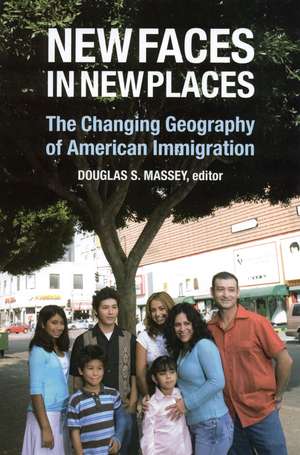New Faces in New Places: The Changing Geography of American Immigration
Editat de Douglas S. Masseyen Limba Engleză Paperback – 3 mar 2010
Beginning in the 1990s, immigrants to the United States increasingly bypassed traditional gateway cites such as Los Angeles and New York to settle in smaller towns and cities throughout the nation. With immigrant communities popping up in so many new places, questions about ethnic diversity and immigrant assimilation confront more and more Americans. New Faces in New Places, edited by distinguished sociologist Douglas Massey, explores today's geography of immigration and examines the ways in which native-born Americans are dealing with their new neighbors. Using the latest census data and other population surveys, New Faces in New Places examines the causes and consequences of the shift toward new immigrant destinations. Contributors Mark Leach and Frank Bean examine the growing demand for low-wage labor and lower housing costs that have attracted many immigrants to move beyond the larger cities. Katharine Donato, Charles Tolbert, Alfred Nucci, and Yukio Kawano report that the majority of Mexican immigrants are no longer single male workers but entire families, who are settling in small towns and creating a surge among some rural populations long in decline. Katherine Fennelly shows how opinions about the growing immigrant population in a small Minnesota town are divided along socioeconomic lines among the local inhabitants. The town's leadership and professional elites focus on immigrant contributions to the economic development and the diversification of the community, while working class residents fear new immigrants will bring crime and an increased tax burden to their communities. Helen Marrow reports that many African Americans in the rural south object to Hispanic immigrants benefiting from affirmative action even though they have just arrived in the United States and never experienced historical discrimination. As Douglas Massey argues in his conclusion, many of the towns profiled in this volume are not equipped with the social and economic institutions to help assimilate new immigrants that are available in the traditional immigrant gateways of New York, Los Angeles, and Chicago. And the continual replenishment of the flow of immigrants may adversely affect the nation's perception of how today's newcomers are assimilating relative to previous waves of immigrants. New Faces in New Places illustrates the many ways that communities across the nation are reacting to the arrival of immigrant newcomers, and suggests that patterns and processes of assimilation in the twenty-first century may be quite different from those of the past. Enriched by perspectives from sociology, anthropology, and geography New Faces in New Places is essential reading for scholars of immigration and all those interested in learning the facts about new faces in new places in America.
Preț: 92.09 lei
Preț vechi: 187.78 lei
-51% Nou
Puncte Express: 138
Preț estimativ în valută:
17.63€ • 18.36$ • 14.63£
17.63€ • 18.36$ • 14.63£
Carte indisponibilă temporar
Doresc să fiu notificat când acest titlu va fi disponibil:
Se trimite...
Preluare comenzi: 021 569.72.76
Specificații
ISBN-13: 9780871545688
ISBN-10: 0871545683
Pagini: 380
Dimensiuni: 152 x 229 x 28 mm
Greutate: 0.57 kg
Editura: Russell Sage Foundation
Colecția Russell Sage Foundation
ISBN-10: 0871545683
Pagini: 380
Dimensiuni: 152 x 229 x 28 mm
Greutate: 0.57 kg
Editura: Russell Sage Foundation
Colecția Russell Sage Foundation
Notă biografică
DOUGLAS S. MASSEY is Henry G. Bryant Professor of Sociology and Public Affairs at the Woodrow Wilson School.
Cuprins
NEW FACES IN NEW PLACES: THE CHANGING GEOGRAPHY OF AMERICAN IMMIGRATION Table of Contents 1. Places and Peoples: The New American Mosaic........................................................1 Charles Hirschman Douglas S. Massey I. NEW PLACES 2. The Geographic Diversification of U.S. Immigration...............................................33 Douglas S. Massey Chiara Capoferro 3. The Structure and Dynamics of Mexican Migration to New Destinations in the United States¿¿¿¿...................................................................................69 Mark Leach Frank D. Bean 4. Changing Faces/Changing Places: The Emergence of Non-Metropolitan Immigrant Gateways...............................................................................................101 Katharine M. Donato Charles Tolbert Alfred Nucci Yukio Kawano 5. The Transformation of the U.S. Food Processing Industry and the Emergence of New Immigrant Destinations.....................................................132 Emilio Parrado William Kandel 6. The Origins of Employer Demand for Immigrants in a New Destination: The Salience of Soft Skills in a Volatile Economy................................................166 Katharine M. Donato Carl L. Bankston III II. NEW FACES 7. Prejudice Toward Immigrants in the Midwest........................................................206 Katherine Fennelly 8. ¿New Midwesterners, New Southerners: Immigration Experiences in Four Rural U.S. Settings¿...................................................................................244 David Griffith 9. Hispanic Immigration, Black Population Size, and Intergroup Relations in the Rural and Small-Town South.......................................................................293 Helen B. Marrow 10. Nashville¿s New Sonido: Latino Migration and the Changing Politics of Race.......................................................................................................341 Jamie Winders 11. The Ambivalent Welcome: Cinco de Mayo and the Symbolic Expression of Local Identity and Ethnic Relations...................................................................379 Debra Lattanzi Shutika 12. Race to the Top? The Politics of Immigrant Education in Suburbia.....................427 Michael Jones-Correa III. CONCLUSION 13. Assimilation in a New Geography¿.¿¿¿¿¿¿¿¿¿¿¿¿¿¿¿¿¿.472 Douglas S. Massey
